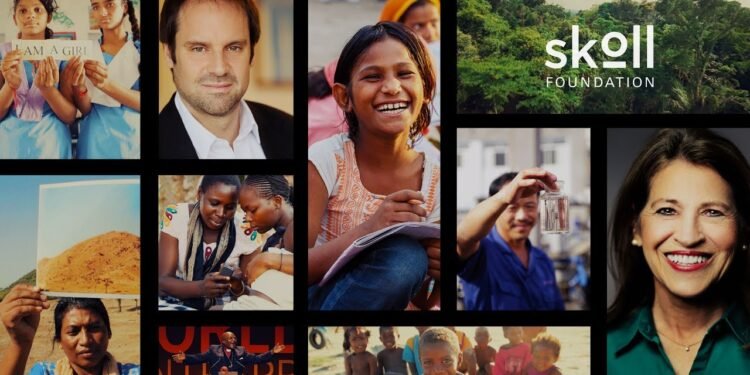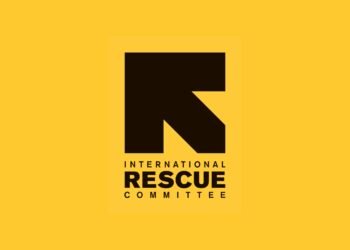What if one person’s vision could transform how we tackle the world’s biggest problems?
Jeffrey Skoll, the first president of eBay, asked this question. His answer became the Skoll Foundation. Founded in 1999, this group works from Palo Alto, California.
The foundation backs social entrepreneurs. These leaders create new ways to fight poverty, climate change, and health issues. They focus on education and research too.
With over $1 billion in assets, the organization makes a huge impact. In 2018 alone, it gave about $71 million in grants. This support helps changemakers across the globe.
Their work spans many years and continents. Partnerships with other groups multiply their effect. This introduction sets the stage for exploring their innovative approach to social change.
Key Takeaways
- The Skoll Foundation was established in 1999 by Jeffrey Skoll, eBay’s first president
- It focuses on supporting social entrepreneurs who drive meaningful change worldwide
- The organization addresses critical issues including poverty, climate change, and education
- With $1.127 billion in assets, it distributed approximately $71 million in grants during 2018
- The foundation operates through strategic partnerships across multiple continents
- It has evolved over the years while maintaining its core mission of innovation in social change
Introduction to the Skoll Foundation
The digital revolution’s success inspired a fresh perspective on solving complex social problems through strategic investment. This innovative approach emerged from California’s tech hub, creating a new model for global philanthropy.
Founding Vision and Mission
Jeffrey Skoll established this philanthropic entity in 1999 after his experience with the eBay Foundation. His vision centered on supporting social entrepreneurs who drive meaningful change worldwide.
The core mission focuses on reducing global poverty through innovative grantmaking. Strategic investments target systemic issues rather than temporary solutions.
This approach represents a shift from traditional charity models. It emphasizes sustainable, scalable solutions to humanity’s most pressing challenges.
Scope of Global Impact
The organization operates across continents from its Palo Alto headquarters. Its geographic reach spans multiple regions and cultures.
Programs address diverse issues including climate change, health disparities, and educational access. Each initiative targets root causes rather than symptoms.
Strategic partnerships amplify the institution’s effect globally. Local organizations receive support to implement culturally appropriate solutions.
Organizational Overview and Structure
Sally Osberg became the first employee and CEO in 2001. Her leadership shaped the early development of the organization’s approach.
The entity moved to its permanent headquarters in 2004. This established its presence in Silicon Valley’s innovation ecosystem.
Operational management involves a unique partnership structure. The Silicon Valley Community Foundation handles day-to-day operations for the Skoll Fund.
Meanwhile, the main institution focuses on program monitoring and strategic direction. This division allows specialized attention to different operational aspects.
The structure supports innovation in social entrepreneurship through flexible funding models. It enables rapid response to emerging opportunities for impact.
Historical Background and Establishment
The transition from Silicon Valley executive to global philanthropist marked a significant shift in one visionary’s career trajectory. This journey began with a clear purpose to address systemic issues affecting communities worldwide.
Jeffrey Skoll’s Philanthropic Journey
After his successful tenure as eBay’s first president, Jeff Skoll embarked on a new mission. He wanted to apply business principles to social challenges.
His experience with digital innovation inspired a fresh approach to philanthropy. The focus shifted to sustainable solutions rather than temporary fixes.
This vision led to the creation of an organization dedicated to supporting social entrepreneurs. These change-makers work on poverty, health, and education issues globally.
Formation and Early Years (1999-2003)
The initial entity was established in 1999 with a clear focus on social entrepreneurship. It began funding awards, grants, and educational programs at leading universities.
Oxford and Harvard became early partners in this educational initiative. This period saw the development of foundational programs that continue today.
In 2003, a significant restructuring created the private Skoll Foundation. Two entities now operated with distinct governance but shared resources.
This structure allowed for more focused grantmaking and program development. The early years established a pattern of innovative thinking about social change.
Evolution of Foundation Priorities
Over the years, the organization’s focus expanded beyond initial social entrepreneurship programs. New global threats demanded attention and resources.
In 2009, the establishment of the Global Threats Fund marked a strategic shift. This initiative focused on pandemic preparedness and prevention research.
Climate change emerged as another critical area of concern. The portfolio grew to address multiple interconnected challenges facing our world.
This evolution reflects responsive leadership adapting to changing global needs. Each new priority builds on lessons learned from previous years of operation.
The endowment grew significantly, enabling larger grants and broader impact. Strategic decisions from this period continue to shape current directions.
Leadership and Organizational Structure
Strategic leadership transitions often mark new chapters in an institution’s development and global reach. The current executive team brings diverse experience from government, business, and social sectors. This blend of expertise strengthens the organization’s approach to complex global challenges.
Key Executive Leadership
Donald Gips became CEO in February 2019 after serving as U.S. Ambassador to South Africa. His diplomatic background informs the institution’s global partnership strategies. Gips focuses on scaling effective solutions to poverty and climate issues.
Marla Blow joined as President and COO in March 2021. She brought extensive experience in financial inclusion and social impact. Blow oversees daily operations and program implementation across continents.
Sally Osberg served as the first employee and CEO from 2001 until 2017. Her tenure established the core grantmaking philosophy. Osberg built the framework for supporting social entrepreneurs worldwide.
Governance and Advisory Boards
The board composition includes leaders from various sectors including business and academia. Members provide strategic guidance on grant allocation and program development. This diverse governance structure ensures balanced decision-making.
Advisory boards offer specialized knowledge on specific issue areas like health and education. They help identify emerging opportunities for maximum impact. Their input shapes the institution’s response to global challenges.
Partnership with Silicon Valley Community Foundation
The Silicon Valley Community Foundation handles day-to-day operations for the Skoll Fund. This partnership allows efficient management of administrative functions. It enables the main organization to focus on program monitoring and strategic direction.
This operational division creates specialized attention to different aspects. The structure supports effective grantmaking through streamlined processes. It represents an innovative approach to philanthropic management.
The collaboration leverages Silicon Valley’s expertise in operational excellence. This model has proven effective for managing global initiatives. It demonstrates how strategic partnerships can enhance organizational capacity.
Major Funding Priorities and Strategic Initiatives
Strategic investment decisions reveal an organization’s true priorities and values. The allocation of resources shows what matters most to leadership and stakeholders.
During a critical fourteen-year period, this group directed substantial funding toward pressing global issues. These investments targeted systemic challenges requiring innovative solutions.
Climate Change and Environmental Advocacy
Environmental concerns received significant attention through major grants. The largest commitment went to the Climate Reality Project.
This initiative received $30 million between 2003 and 2017. It focused on raising awareness about climate issues worldwide.
Other environmental groups also benefited from this strategic focus. Their work addressed various aspects of ecological preservation.
Poverty Alleviation Programs Worldwide
Fighting poverty remained a central mission throughout this funding period. Programs reached both developing nations and the United States.
The One Acre Fund emerged as a major recipient with $18.3 million. This organization helps smallholder farmers increase their harvests.
Other anti-poverty initiatives received substantial support as well. These efforts collectively formed the largest area of investment.
Educational Initiatives and Teacher Development
Education received focused investment, particularly for children living in poverty. Teacher development programs formed a crucial part of this strategy.
The New Teacher Center received support for improving instructional quality. Their work helps educators succeed in challenging environments.
Other educational organizations also benefited from these grants. They worked to create better learning opportunities for underserved communities.
Public Broadcasting and Media Partnerships
Media partnerships played an important role in the communication strategy. Public broadcasting received $8.2 million during this period.
This funding supported PBS, NPR, and other media outlets. Their programs help educate the public about critical social issues.
Film projects also received support for creating social impact. These partnerships extended the reach of important messages.
Community Foundation Support
The Silicon Valley Community Foundation received $10.4 million in support. This partnership helped manage various philanthropic activities.
Other community foundations also benefited from this strategic approach. They helped distribute resources to local organizations effectively.
This model allowed for efficient management of grant programs. It demonstrated innovative thinking about philanthropic operations.
Skoll Foundation Programs and Recognition
Innovative programs create powerful platforms for social entrepreneurs to connect and grow. These initiatives bring together leaders from around the world. They share ideas and build networks to drive meaningful change.
Skoll Awards for Social Entrepreneurship
The annual awards celebrate outstanding social entrepreneurs. Each recipient receives funding and support. The selection process focuses on impact and innovation.
Notable winners include groups fighting poverty and improving health. Their work spans many countries and issues. These awards help raise awareness through powerful storytelling.
Skoll World Forum on Social Entrepreneurship
This global gathering brings together change-makers each year. Attendance grew to 1,200 people from 80 countries by 2019. It creates a vibrant space for sharing ideas and strategies.
Notable speakers have included Kofi Annan and Malala Yousafzai. Desmond Tutu, Al Gore, and Jimmy Carter also shared insights. Their participation adds prestige to the event.
Skoll Centre for Social Entrepreneurship at Oxford
Oxford University became home to this important center in 2003. A $7.5 million donation made it possible. The center focuses on education and research for social good.
Students learn how to create positive change in the world. Research initiatives explore new solutions to old problems. This academic partnership strengthens the entire field.
Global Threats Fund Initiatives
This fund addresses critical challenges facing our world. It started in 2009 with a focus on multiple threats. Climate change and pandemics receive special attention.
Water security and nuclear proliferation are also priorities. The fund supports work on conflict in the Middle East. It has responded to specific crises like pandemic preparedness.
These programs collectively advance the organization’s mission. They create ecosystems where social entrepreneurs can thrive. The recognition associated with these initiatives is highly respected.
Impact Assessment and Global Reach
Measuring real-world results shows how strategic investments create lasting change across continents. The organization’s approach combines data-driven analysis with human stories of transformation.
Geographical Distribution of Grants
Funding reaches every corner of our planet through carefully planned allocation. Resources flow to areas with the greatest need and potential for impact.
African nations receive significant support for health and agriculture programs. Asian countries benefit from education and climate initiatives. Latin American projects focus on poverty reduction and community development.
The United States remains an important recipient for domestic programs. This global spread ensures diverse communities receive targeted assistance.
Key Success Stories and Case Studies
One Acre Fund demonstrates remarkable achievement in agricultural development. Smallholder farmers increase harvests by 50% with proper training and resources.
This success directly fights poverty in rural communities. Families gain food security and economic stability.
Climate change initiatives show measurable environmental improvements. Renewable energy projects reduce carbon emissions significantly. Community adaptation programs help vulnerable regions withstand environmental shifts.
Education programs transform learning outcomes for children worldwide. Teacher development creates lasting change in classroom quality. These efforts show how strategic funding creates cascading benefits.
Financial Scale and Grantmaking Capacity
The financial commitment reflects serious dedication to global improvement. During 2003-2017, the organization distributed $301.7 million through strategic grants.
Large donations accounted for 71% of this total amount. This focused approach maximizes impact where it matters most.
In 2018 alone, grantmaking reached approximately $71 million. This consistent funding creates stability for long-term projects.
The pandemic response showed remarkable adaptability. Emergency funding increased to $200 million in 2020. This rapid scaling addressed urgent health needs worldwide.
Partnerships with Major Organizations
Collaboration multiplies impact through shared expertise and resources. Google.org joins forces on technology-driven solutions. Their combined efforts accelerate digital innovation for social good.
Public health agencies receive support for critical initiatives. The African Field Epidemiology Network strengthened pandemic response capabilities. Africa Centres for Disease Control enhanced regional health security.
Educational institutions partner on research and program development. These alliances create knowledge-sharing networks that benefit entire fields.
Film organizations help tell powerful stories of change. Documentaries raise awareness and inspire action on global issues. This multimedia approach expands reach beyond traditional grantmaking.
Each partnership brings unique strengths to the table. Together, they create solutions no single group could achieve alone. This collaborative model represents the future of effective philanthropy.
Conclusion
The landscape of global philanthropy has been fundamentally reshaped by an innovative approach to social entrepreneurship. Over two transformative decades, this organization has demonstrated how strategic vision can drive meaningful social change.
The Skoll Foundation’s model differs from traditional charity by focusing on systemic solutions rather than temporary fixes. Its support for social entrepreneurs has created lasting impact across climate action, poverty reduction, and educational access.
From its 1999 establishment to today’s global reach, the foundation has evolved to address emerging challenges. Its work continues to inspire new approaches to humanity’s most pressing issues.
Future directions will likely build on lessons learned while adapting to changing global needs. This innovative philanthropic approach shows no signs of slowing its pursuit of positive change.
FAQ
What is the primary mission of the Skoll Foundation?
The organization’s core mission is to drive large-scale social change by investing in, connecting, and celebrating social entrepreneurs and other innovators dedicated to solving the world’s most pressing problems.
Who founded the Skoll Foundation and when was it established?
Jeffrey Skoll, the first employee and first President of eBay, established the foundation in 1999 to pursue his vision of a sustainable world of peace and prosperity.
What are the main global issue areas the foundation focuses its funding on?
Its major funding priorities include climate change and environmental sustainability, systemic poverty alleviation, educational access and teacher development, and supporting trustworthy media and public broadcasting.
What is the Skoll Award for Social Entrepreneurship?
This prestigious award recognizes outstanding social entrepreneurs whose work has transformative potential. Recipients receive a significant financial grant and gain access to a supportive community to help scale their impact.
How does the foundation partner with the Silicon Valley Community Foundation?
The organization operates as a supporting organization of the Silicon Valley Community Foundation, which provides administrative and investment management services, allowing it to focus more intently on its core philanthropic programs.
What is the Skoll World Forum?
It is a premier international gathering convened annually in Oxford, England. The event brings together leading social entrepreneurs, policymakers, and thinkers to accelerate collaborative solutions to global challenges.





